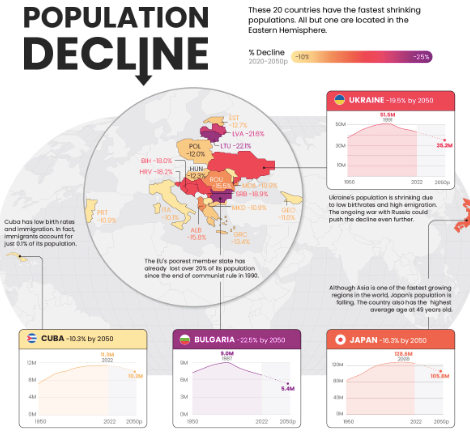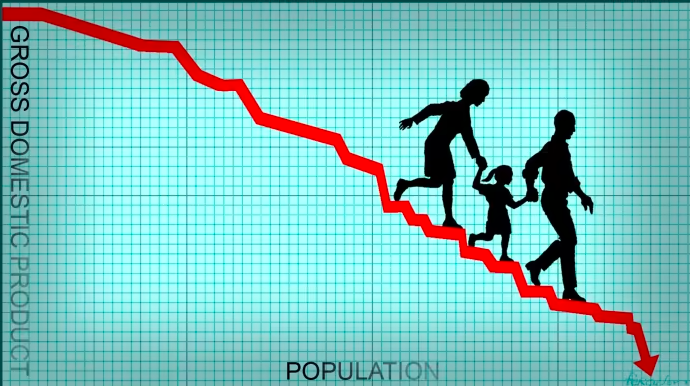Is it growing? Population rate in the world
For centuries, the world's population has been on a constant rise; however, recent evidence suggests that this trend might be slowing down. Even though some parts of the world still undergo substantial population growth, other regions are observing a decrease in population

the global population has been steadily increasing for centuries, but there is evidence to suggest that this trend may be slowing down. While some regions of the world continue to experience significant population growth, others are seeing declining populations due to factors such as aging, declining fertility rates, and migration.
Population Growth
Population growth has been a defining feature of human civilization for thousands of years. The world's population has grown from an estimated 300 million people in 1 CE to over 7.9 billion people today. This exponential growth has been driven by a combination of factors, including improved medical care, increased agricultural productivity, and advances in technology and infrastructure.

However, there are concerns that unchecked population growth could have negative impacts on the environment, public health, and social and economic stability. Some experts argue that population growth could lead to resource depletion, pollution, and climate change, as well as increased competition for jobs and resources.
Population Decline
Despite the ongoing global population growth, there are several regions where populations are declining. These regions include parts of Europe, Asia, and North America, where aging populations and declining fertility rates are leading to shrinking populations.
Aging populations are a major driver of population decline in many countries. As people live longer and have fewer children, the proportion of older adults in the population increases. This can lead to a range of social and economic challenges, such as a shrinking workforce, rising healthcare costs, and increased demand for social services.
Declining fertility rates are another factor contributing to population decline. In many developed countries, women are having fewer children than in previous generations, often due to factors such as changing social norms, access to birth control, and career aspirations. This trend has led to concerns about the long-term viability of certain societies, as shrinking populations can lead to reduced economic growth, fewer taxpayers to support social programs, and reduced cultural and linguistic diversity.
Migration is another factor that can contribute to population decline in some regions. As people move from one place to another, it can lead to demographic shifts and changes in population size. For example, rural areas may experience population decline as young people move to cities in search of work, while urban areas may experience population growth due to immigration.
Declined by fertility rate

Due to a sudden drop in the global total fertility rate from 5.3 in 1963 to 2.4 in 2019, population growth has declined. The decline in the fertility rate is a result of the demographic transition process and has been observed in every region of the world. To sustain their population without considering migration, countries require a minimum fertility rate of 2.1 children per woman, which is slightly above 2 due to infant mortality rates. However, as societies become more affluent, their fertility rate drops drastically to well below 2. This tendency of women in wealthier countries to have fewer children is attributed to several reasons, including lower infant mortality, reduced need for children as a source of family labor or retirement welfare, and better access to education for young women that broaden their job prospects.
The consequences of a long-term national population decline can be either net positive or negative. Suppose a country can improve its workforce productivity faster than its declining population. In that case, the results can be net positive, leading to an improved economy, enhanced quality of life for citizens, and better environmental conditions. However, if a country cannot increase workforce productivity at a faster rate than the population's decline, the results can be negative.
National efforts to tackle a declining population have so far focused on potential negative economic outcomes, with efforts centered on increasing the size and productivity of the workforce.

Population decline in overpopulated places
In some cases, population decline is seen as a positive development, particularly in areas where overpopulation has led to environmental degradation, resource depletion, and overcrowding. However, declining populations can also lead to their own set of challenges, such as economic stagnation, reduced innovation and entrepreneurship, and a shrinking tax base to support social programs.
One potential solution to population decline is immigration. Many countries with declining populations have implemented policies to attract immigrants to bolster their population numbers and workforce. However, this approach can be controversial and politically charged, particularly in countries where there is a perception that immigrants may compete with native-born workers for jobs and resources.

Another potential solution is to address the underlying factors driving population decline. This may involve policies to support families and encourage childbearing, such as parental leave, subsidized childcare, and tax incentives for families with children. It may also involve efforts to promote economic growth and entrepreneurship, such as investment in education, research and development, and infrastructure.
Here is a table summarizing some of the main causes of population decline and growth:
| Causes of Population Decline | Causes of Population Growth |
|---|---|
| Aging population and low fertility rates | High fertility rates |
| Decrease in infant mortality rates | Immigration |
| Epidemics and diseases | Medical advancements and improved healthcare |
| War and conflict | Increase in life expectancy |
| Environmental disasters and natural calamities | High birth rates in developing countries |
| Emigration and brain drain | Cultural and religious beliefs that promote larger families |
Please note that this table is not exhaustive and there may be other factors contributing to population decline and growth.
Conclusion
While the global population continues to grow, there are signs that this trend may be slowing down in some regions of the world. Aging populations, declining fertility rates, and migration are all contributing to population decline in certain areas, while others continue to experience significant population growth. As we consider the implications of these demographic shifts, it is important to continue to monitor trends in population growth and work to address the challenges and opportunities that come with a changing global population.




